As a Turkish and a Turkic, I feel that the Turkic language family is not known much. In this blog, I will try to shed light on facts about the Turkic languages.
Turkish refers to Turkish people who have their origins in Turkey, and Turkic refers to an ethnic group of people who have their ancestral origins in Central Asia.
Turkic is a term that also refers to a language family.
Turkic language family is a group of languages that are very closely related to today’s Latin languages, like Portuguese, Spanish, Italian, and French.
Turkic is a language family that includes Turkish, Turkmen, Azerbaijani, Uzbek, Uyghur, Tatar, Kazakh, and Kyrgyz.
Some scholars claim that Turkic languages are more related than Latin languages, and it is wrong to call each a language but dialects of each other. In this sense, Turkish is the Istanbul dialect of the Turkic Language.
My personal experience is that some Turkic languages could be considered dialects of each other.
For example, as a native Turkish speaker, I feel Turkish and Azerbaijani could easily be considered the same language with dialect differences.
As an Istanbul dialect speaker, it is sometimes easier for me to understand Azerbaijani than some dialects of Turkish.
If you are interested in learning the Turkish language, this is the book that most of my friends use. You can check the book on Amazon.
1. Turkic Languages in Brief
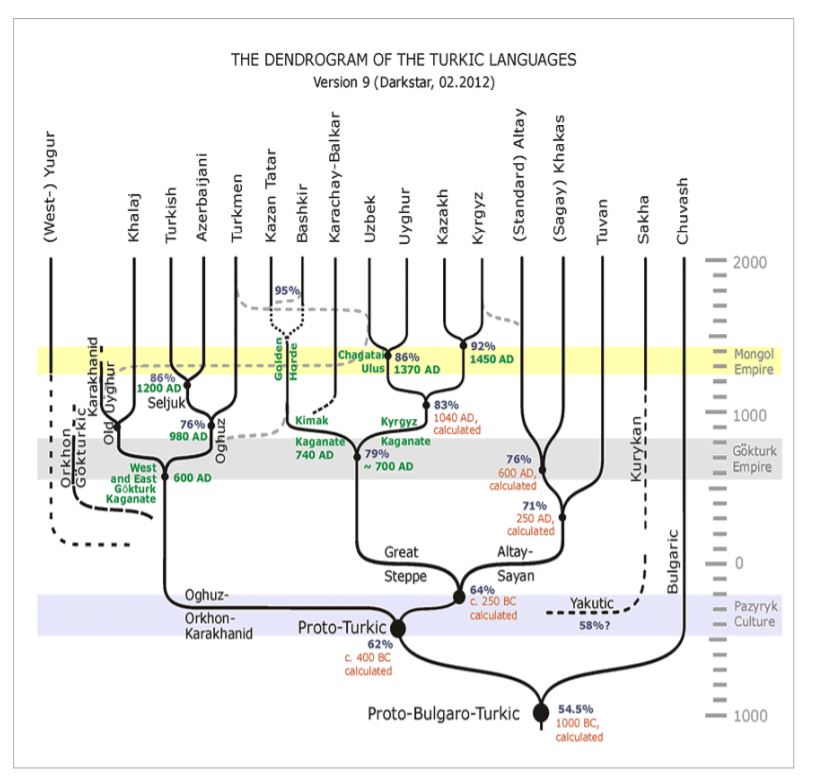
All Turkic languages come from the Proto-Turkic language, which was the spoken language of Turkic people 3000 years ago, around 1000 B.C.
This ancient Turkic language evolved into Turkish, Turkmen, Azerbaijani, Uzbek, Uyghur, Tatar, Kazakh, Kyrgyz, and other Turkic languages.
There are 4 main subgroups of Turkic Languages. These are
- Oghuz languages with 125,400,000 native speakers (red area on the map)
- Karluk languages with 38,000,000 native speakers. (orange area on the map)
- Kipchak languages with 28,300,000 native speakers. (green area on the map)
- Siberian Turkic languages with 1,200,000 native speakers. (blue area on the map)
In total, there are around 193,700,000 native speakers of Turkic languages.
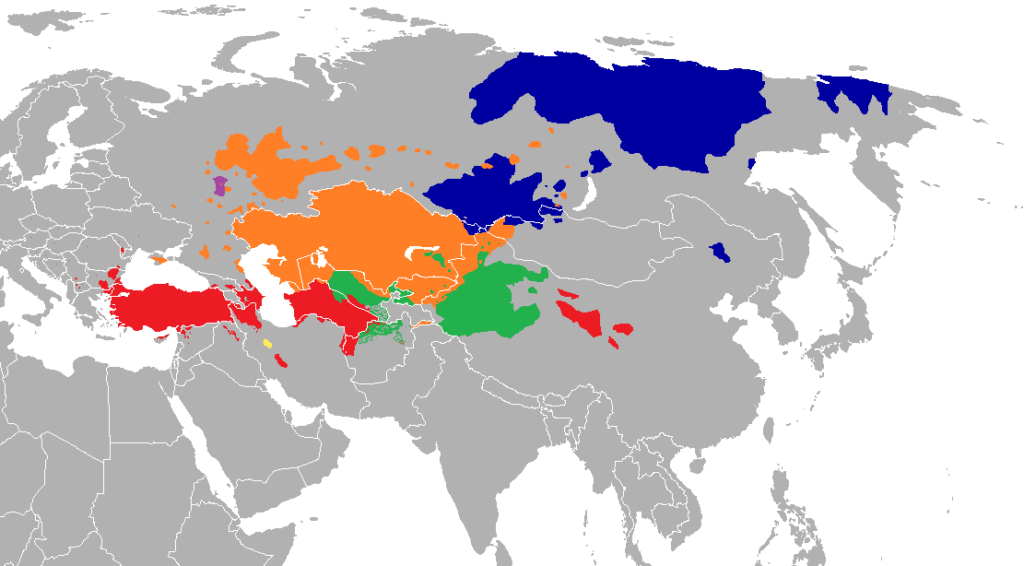
Hungarian is also being accepted as a Turkic Language by the Organization of Turkic States and Hungary. More on this later.
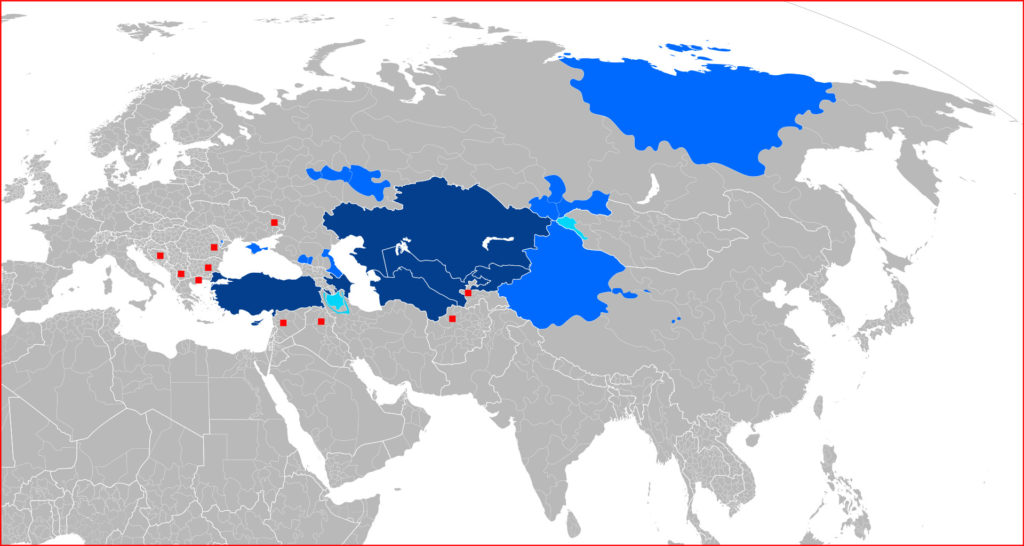
Map showing where Turkic Languages are spoken as the official language (blue), regional language (light blue), and minority language (red dot) Source
Minority Languages only account for the native population in this map.
Austria, Sweden, Denmark, France, Germany, the UK, and Germany are also home to a sizable Turkish/Turkic Diaspora.
Suggested Reading: What Do Turkish People Look Like? With Pictures and History
2. Turkic Languages and Number of Native Speakers
Turkish is the most spoken Turkic language, and the Oghuz branch is the most spoken branch of the Turkic Language Family.
Turkish belongs to the Oghuz branch of the Turkic Languages. The other major languages in the Oghuz branch are Azerbaijani and Turkmen.
Out of 193 million native speakers of Turkic Languages, 83 million speak the Turkish language.
The Oghuz branch accounts for 126 million of 193 million native speakers of Turkic Languages.
| Language | Number of Speakers | Countries with Majority of Speakers | Alphabet |
| Turkish | 83 Million | Turkey, North Cyprus | Latin |
| Azerbaijani | 33 Million | Azerbaijan, Iran | Latin, Perso-Arabic (in Iran) |
| Uzbek | 27 Million | Uzbekistan | Latin |
| Kazakh | 14 Million | Kazakhstan | Latin |
| Uyghur | 11 Million | China (semi-autonomous Uyghur region) | Perso-Arabic |
| Turkmen | 7 Million | Turkmenistan | Latin |
| Tatar | 5,5 Million | Russia (Tatarstan Federal Republic) | Cyrillic |
| Kyrgyz | 5 Million | Kyrgyzstan | Cyrillic |
Languages spoken in Turkey and Languages spoken in Istanbul are good guides to learning more about languages spoken in Turkey.
3. Characteristics
There are around 35 documented Turkic Languages, but because Turkic languages are spread over a wide geography with a dialect continuum model, it is hard to differentiate dialects and languages.
Turkic languages share several common features:
- Agglutinative Structure: They typically use affixes to indicate grammatical functions, resulting in long, compound words.
- Vowel Harmony: Most Turkic languages use vowel harmony, where vowels within a word harmonize to be either front or back, rounded or unrounded.
- Subject-Object-Verb (SOV) Order: The typical sentence structure in Turkic languages is subject-object-verb.
4. Mutual Intelligibility
Geographical proximity generally helps the mutual intelligibility between Turkic Languages. Yet, Turkic languages
Robert Lindsay prepared the diagram below to demonstrate common words (cognates) in Turkic languages and their relations.
As seen in the chart, it is very obvious that Turkic languages share a common heritage.
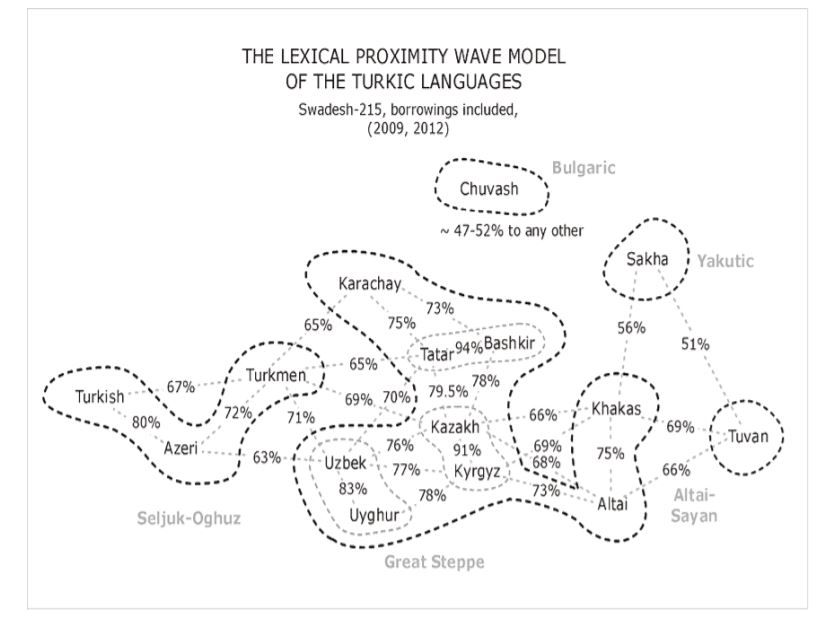
Robert Lindsay also stated there is limited mutual intelligibility between Turkic languages depending on the number of cognates.
According to Lindsay, if two languages are cognates below 60%, there is essentially zero intelligibility, and as a Turkish speaker, I have no chance of understanding Uyghur and Uzbek.
Yet, this is not true.
I am not a linguist, but as a native speaker, I disagree with Lindsay.
The Turkic languages are about the verbs and not about the words. By adding suffixes to verbs, you can create sentences with one word.
For this reason, a cognate study would not reveal much about the mutual intelligibility of Turkic languages.
I am a native Turkish speaker with no language training in any Turkic language.
Yet, it is easy for me to open Kazakh news websites and read Kazakh news even though they use slightly different alphabets and sounds.
I may not understand the text thoroughly, but I will have a good idea of what’s happening.
The written form of Turkic languages is much more intelligible, but the spoken language is harder to understand due to accent differences.
Mutual intelligibility between Turkic languages can be increased drastically with personal practice.
Uyghur people living in the Turkestan region of China can speak and understand Turkish with 15% mutual intelligibility at first instance.
Yet, given a few days or weeks, the mutual understanding of Uygur speakers rises by around 75% for Turkish. This is also true for Turkish natives with the Uyghur language. Source
In my opinion, the Turkic language differences mostly lie with the accent and loanwords, yet grammatical structure remains the same across Turkic languages.
5. Languages and Language Families Similar to Turkic Languages
Here is the map for all world language groups in the world.
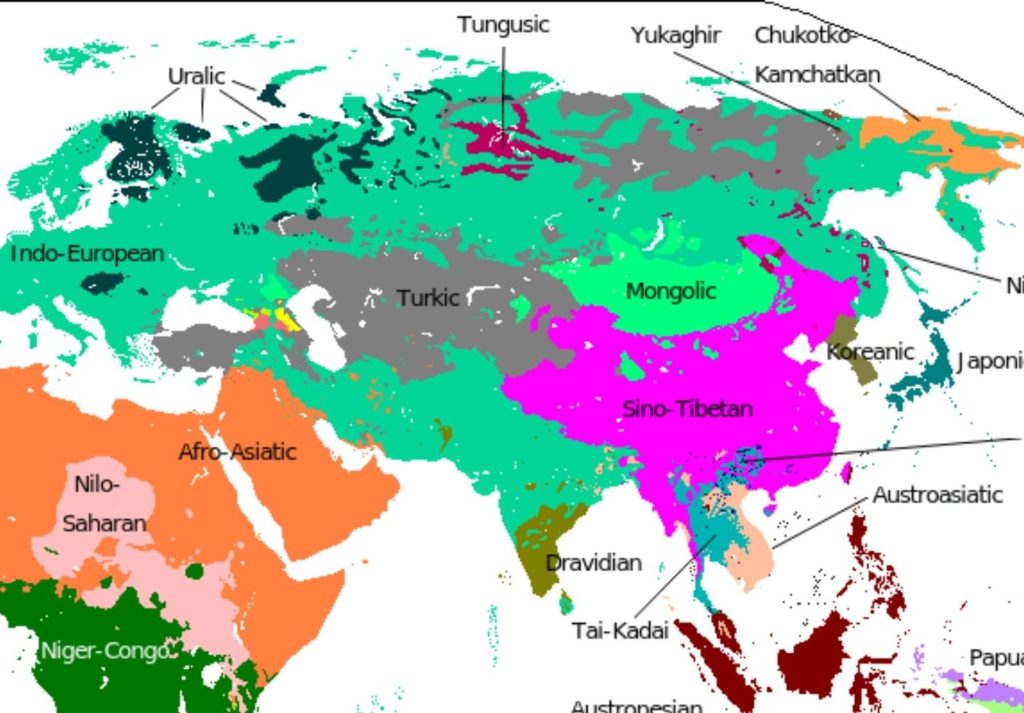
According to different language studies and theories, Uralic, Mongolic, Koreanic, Japonic, and Turkic languages share a common ancestor and have evolved from the same origin.
In this section, I will be giving details about languages and language families similar to the Turkic language family.
Just a side note: despite some objections to these language theories, my friends also find Uralic and Altaic languages easier to grasp than other languages.
As for their experience, Turkish people have an easier time learning Hungarian, Korean, and Japanese than English and German because their grammatical logic is similar to Turkish.
5.1 Altaic Language Family
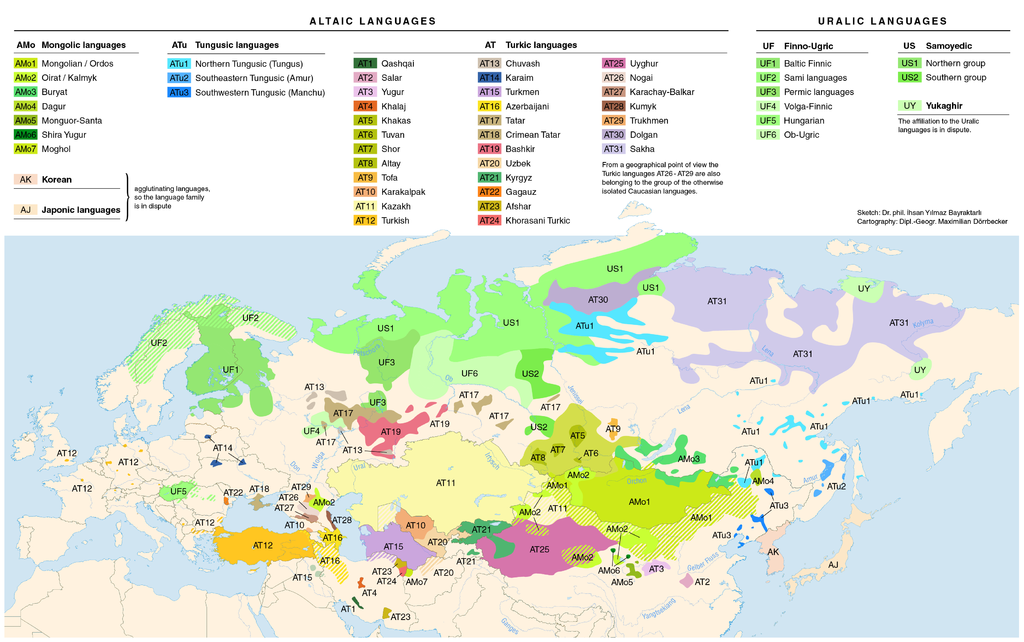
According to the Altaic Language Family theory, Mongolian, Korean, and Japanese are considered Altaic Languages.
Altaic Language theory was widely accepted until the 1960s, yet in recent decades, it has been widely criticized by academic circles.
5.1.1 Turkic vs Mongolic Languages
Mongols are not Turkic people.
Turkic and Mongolian people both have their origins in Central Asia, and the Mongolian language is the closest language to the Turkic language family.
Mongols even used the old Turkic (Uighur) alphabet to write Mongolian until 1946. Source.
According to Transeurasian Language theory, Proto-Mongol and Proto-Turkic Languages evolved from the same ancestral language thousands of years ago.
5.1.2 Turkic vs Korean Languages
The Korean language has some similarities with Turkic languages’ grammar structures.
Both Korean and Turkic Languages share grammatical features of agglutination, sentence structure, the syntax of adjectives and nouns, and vowel harmony.
Yet, the theories about the connection between Korean and Turkic languages have not been proven and are not widely accepted.
5.1.3 Turkic vs Japonic Languages
Several language theories connect Japanese with Korean, Mongolian, and Turkic languages. Yet, most theories are widely rejected. Source
5.2 Uralic Languages
For a long time, the Uralic Languages of Finnish, Estonian, and Hungarian have been associated with Turkic and other Altaic languages.
According to researchers, Finnish and Estonian have similar grammar rules to Turkic languages.
Agglutination, suffixation, and vowel harmony are shared features of Turkic, Finnish, and Estonian languages.
While I have no first-hand experience, my search through forums revealed many learners of these languages, confirming some degree of grammatical similarity.
5.6 Hungarian

Hungary was established by the Huns, and the Huns were accepted as one of the Turkic tribes by Turkic people.
For this reason, Hungary and Turkic countries are becoming more and more aligned politically.
Despite the similarities between Hungarian and Turkic Languages, the Hungarian Language is distinctly different from other Turkic languages.
Yet, Turkish and Hungarian have many loanwords due to cultural exchanges during the 15th and 18th centuries when parts of Hungary were under Turkish rule.
You can also check my language-related articles on Greek vs Turkish, Persian and Turkish, and Arabic vs Turkish to learn more about the differences between these languages and Turkish.
6. Chinese language vs Turkic languages
Chinese people have lived and influenced Turkic languages since the beginning because Turkic languages have their roots in Eastern China and Mongolia.
Yet, Chinese is a Sino-Tibetan language and very different from Turkic Languages.
Still, various Turkic groups live in China. Uyghur language, with its 11 Million native speakers, is the most spoken Turkic Language in China.
Additional Reading Suggestion: Languages Similar to Turkish – Is Turkish Mutually Intelligible? and Is Turkish a Language? Origins of the Turkish Language
7. Are Turkic Languages Easy or Hard to learn?
Turkic Languages may be hard to grasp for English and other Indo-European speakers.
Learning one of the Turkic languages makes it easier to learn the others. The logic and grammatical structure of Turkic languages are very similar.
As a native Turkish speaker, I can attest that I have a limited understanding of some Turkic languages.
Yet, verbs are the backbone of Turkic languages. Turkic verbs have a higher degree of mutual intelligibility through Turkic languages.
For this reason, even if you do not usually understand the other words, you can somewhat grasp the meaning by understanding the verb of the sentence.
8. Which Turkic Language should you learn?
Turkish may be the easiest Turkish language among Turkic languages.
The Turkish language was reformed extensively around the 1920s. For this reason, the Turkish language is highly standardized with minor grammar irregularities.
At the same time, Turkish started changing the Latin alphabet; the differences between the dialects of the Turkish language are minor.
The main Turkish dialect spoken by the Turkish people is the Istanbul dialect and understandable by all Turkish native speakers. Additionally, the Istanbul dialect is the most spoken dialect among Turkic Languages.
Lastly, the Turkish language is also highly mutually intelligible with the Azerbaijani language, even for new beginners. By the way, Azerbaijani is the second most spoken Turkic language.
ALL MY ARTICLES ABOUT TURKISH LANGUAGE – (Click on the title to read)
Origins of the Turkish Language – A Native Speaker Explains
Languages Similar to Turkish – Explained by a Native Speaker
What Languages Do Turkish People Speak?
What Languages are Spoken in Istanbul?
Turkic Language Family – A Turkish Explains
Turkish vs Persian (Farsi) Language: Similarities and Differences
